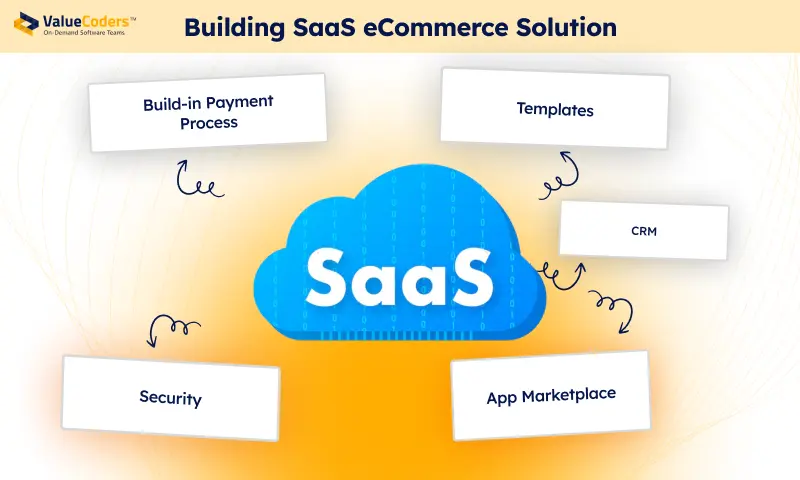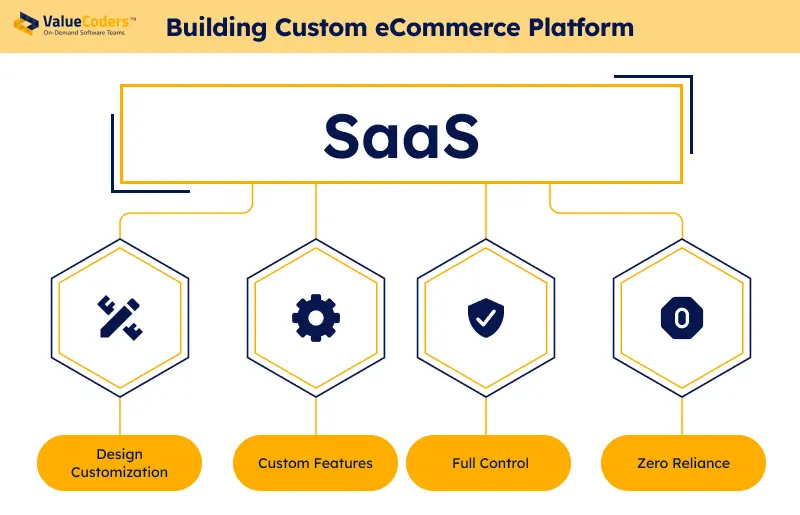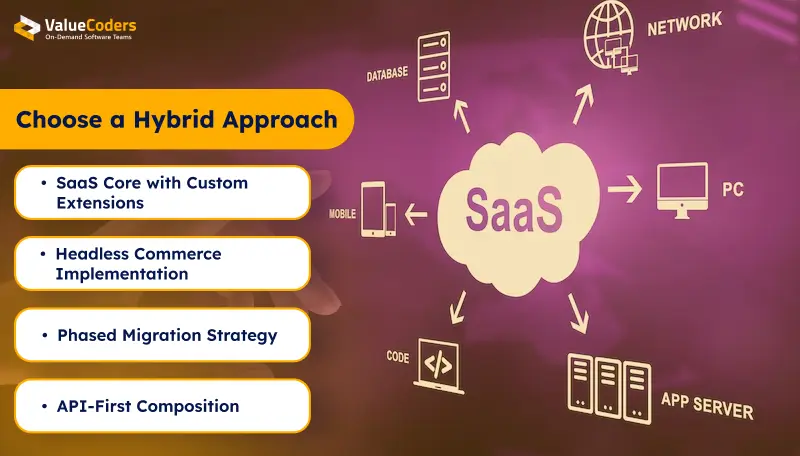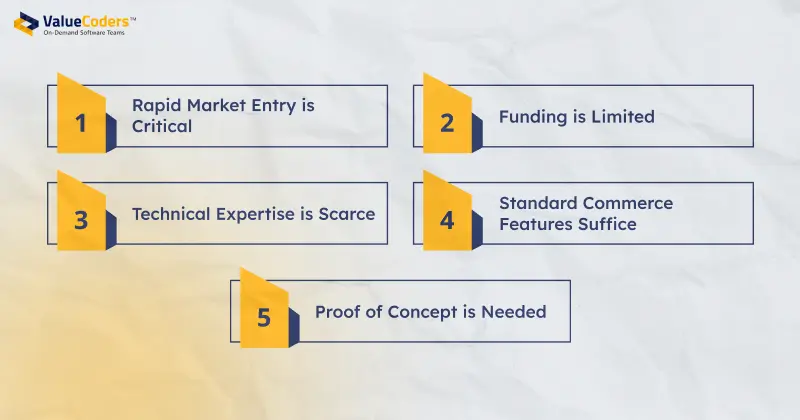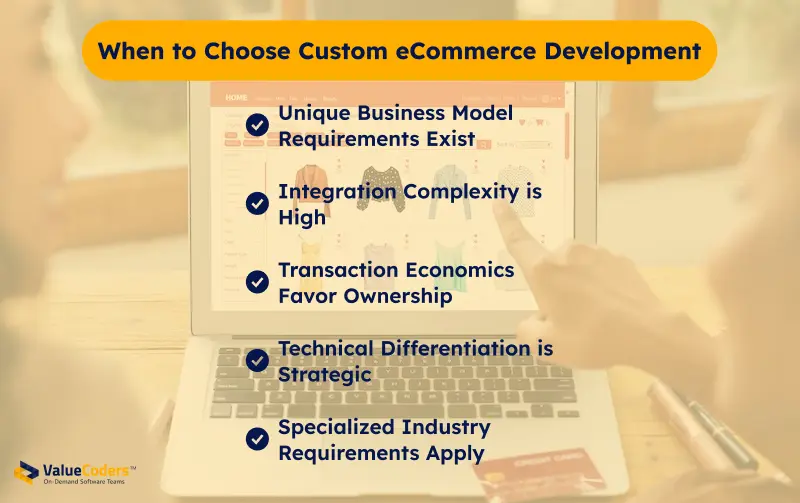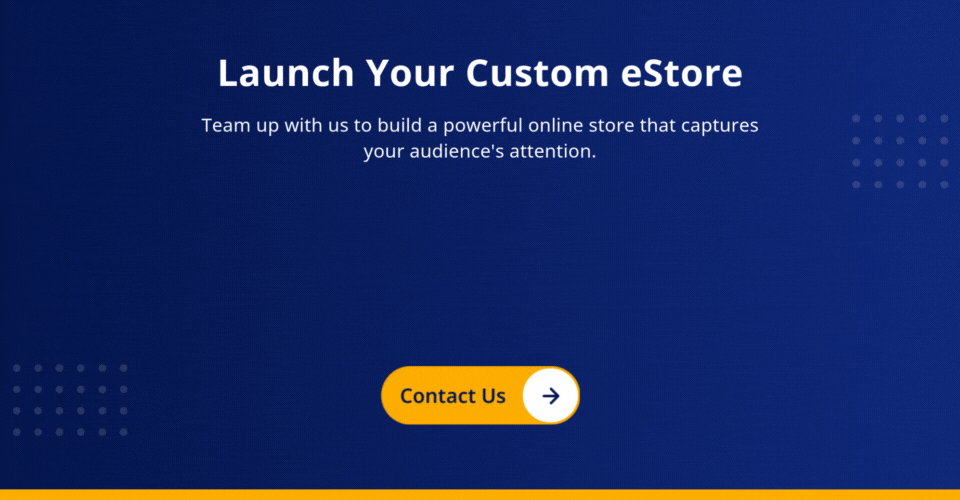Did you know the global eCommerce market is expected to reach $4.3 trillion in 2025? With this growth, startups must carefully choose the right eCommerce platform to ensure success.
If you want your startup to capture a part of that market, the choice will shape everything:
- How fast you launch.
- How much do you scale?
- How competitive you stay.
Whether you choose a plug-and-play SaaS solution like Shopify or BigCommerce, or build a custom platform tailored to your unique needs, each path has its perks and its pitfalls.
If you’re aiming for speed and simplicity, SaaS might seem like a no-brainer. But what if you need total flexibility, scalability, and control?
This guide breaks down the differences between SaaS and custom eCommerce platforms, so you can pick the right one based on your startup’s vision, budget, and growth goals.
What are SaaS eCommerce Solutions?
SaaS (Software-as-a-Service) eCommerce solutions are ready-made software for building websites. It’s a subscription-based, cloud-hosted solution to get your store up and running fast without writing a single line of code.
Popular platforms include:
- Shopify
- BigCommerce
- WooCommerce
These tools come pre-packed with everything a startup needs to launch quickly:
- Professionally designed templates
- Built-in payment processing
- Hosting, security, and platform updates
- App marketplaces to expand functionality
- Standard tools for product, order, and shipping management
Whether you're just starting or ready to grow, we’ll help you launch with confidence.
What Is Custom eCommerce Development?
Custom development is exactly what it sounds like. It’s ideal for businesses with unique workflows, such as subscription-based services or multi-vendor marketplaces. A custom platform is built from scratch for your business by your developers.
It’s about control, flexibility, and complete ownership.
Custom eCommerce development gives you:
- Custom design and features
- Deep integrations with your existing systems
- Full control over performance, security, and scaling
- Zero reliance on third-party platforms
We develop bespoke eCommerce platforms that match your unique vision and business goals.
Key Considerations for Startups
For startups specifically, several factors must be carefully weighed when choosing between SaaS and custom solutions:
| Factor | SaaS eCommerce | Custom eCommerce |
| Time-to-Market | Days or weeks to launch | 3-6+ months of development time |
| Initial Investment | $29-299 monthly subscription, $100-300 for themes | $30,000-$250,000+ upfront cost |
| Long-term Costs | Accumulating subscription fees | Higher upfront cost but potentially lower TCO over 5+ years |
| Flexibility | Limited by platform architecture and features | Complete freedom to implement unique requirements |
| Customization | Constrained within platform boundaries | Unlimited customization possibilities |
| Scalability | Can handle growth but with increasing costs | Can be engineered specifically for anticipated growth patterns |
| Performance | May suffer as volumes increase | Optimized for specific business requirements |
| Maintenance | Handled by the platform provider | Requires dedicated resources or ongoing developer support |
| Best For | Quick market entry, limited budget, standard requirements | Unique business models, complex operations, long-term growth |
Advantages and Limitations for SaaS Startups
Understand why you should choose SaaS for your startup. Below we have mentioned the pros and cons of SaaS base eCommerce.
Advantages
1. Quick Launch and Iteration
You can launch your store in days, test product-market fit, and make changes based on real customer feedback. This allows entrepreneurs to improve customer satisfaction without a deep technical setup.
2. Predictable Expenses
SaaS solutions offer budget certainty with fixed monthly costs. This predictability allows financial planning and reduces the risk of unexpected expenditures.
3. Built-in Support and Maintenance
SaaS providers handle updates, uptime, and security in the background. This facility allows businesses to focus on growth and improvement, not glitches.
4. Compliance and Security Standards
Top SaaS eCommerce platforms maintain security certifications like PCI DSS, GDPR compliance, etc., providing security without the associated costs and expertise requirements.
5. Proven Success Patterns
Startups benefit from battle-tested user experiences and conversion optimizations refined across thousands of stores. This access to proven patterns significantly reduces the risk of major UX missteps.
Limitations
1. Feature Constraints
Despite extensive app ecosystems, SaaS platforms may not support highly specialized features or industry-specific requirements without compromise or workarounds.
2. Transaction Fee Impact
Many SaaS eCommerce solutions charge per-transaction fees. High-volume businesses may find these fees particularly burdensome.
3. Platform Dependency
Businesses built entirely on SaaS platforms face potential disruption from policy changes, pricing adjustments, or even platform discontinuation. This dependency creates a vulnerability that custom solutions avoid.
4. Differentiation Challenges
With thousands of businesses using identical platform foundations, startups may struggle to create truly distinctive shopping experiences that stand out in crowded markets.
Also Read : How to Bootstrap a SaaS Startup in 2025?
Custom eCommerce Development: Advantages and Limitations for Startups
Here are the pros and cons of custom eCommerce development.
Advantages
1. Complete Technical Freedom
Custom eCommerce development removes all technical limitations, allowing startups to implement innovative features. This gives businesses a novel impression or a unique selling proposition.
2. Seamless Integration Capabilities
Custom platforms offer unparalleled integration potential with inventory management and ERP systems to startups with complex operational requirements.
3. Performance Optimization
A custom platform is faster and easier to navigate than a SaaS solution. It is designed as per business traffic patterns and operational needs.
4. Intellectual Property Creation
Custom-developed platforms become valuable intellectual property assets for the business, potentially increasing company valuation and creating barriers to competition through proprietary technology.
5. No Revenue Sharing
Unlike many SaaS platforms, custom solutions eliminate transaction fees or revenue sharing, potentially saving significant costs as transaction volumes grow.
6. Tailored User Experience
It provides businesses with a custom solution that addresses their unique business needs. You can choose an eCommerce development service and design according to your requirements.
Limitations
1. Development Complexity and Risk
Custom projects face higher risks of delays, budget overruns, and technical complications. Without experienced management and development teams, these risks can threaten startup viability.
2. Ongoing Maintenance Burden
Custom platforms require dedicated technical resources for maintenance, security updates, and ongoing development. This responsibility represents both a financial and operational commitment.
3. Higher Initial Investment
The substantial upfront cost of custom development diverts capital from other critical startup needs like marketing, inventory, and team expansion.
4. Evolution Responsibility
While SaaS platforms continuously evolve with new features and capabilities, custom platforms only improve through additional investment. This places the burden of innovation entirely on the startup.
Unlock the true potential of your online business with ValueCoders' expert eCommerce solutions.
Hybrid Approaches: The Best of Both Worlds
Many successful startups are discovering that the SaaS vs. custom decision isn’t binary. Innovative hybrid approaches are emerging as pragmatic solutions:
1. SaaS Core with Custom Extensions
Using a SaaS platform as the foundation while developing custom applications or microservices for specific functionality needs. Businesses often engage SaaS Consulting and Development Services to help design and implement these proprietary extensions while preserving the core advantages of the SaaS model.
Nike adopted a headless commerce architecture by integrating a React Single Page Application (SPA) on the frontend with a Node.js Backend for Frontend (BFF). This setup allowed Nike to tailor mobile experiences without altering backend systems, enhancing agility and user engagement.
Result:
- Boosted mobile conversions by 83%
- Improved page load speed by 65%
2. Headless Commerce Implementation
Adopting a headless architecture where the SaaS platform handles backend commerce functionality while a custom frontend delivers unique user experiences. This approach is gaining popularity among digitally sophisticated startups.
LARQ combined BigCommerce (a SaaS platform) for backend operations with a custom-built frontend using React. This headless commerce setup enabled them to manage global storefronts under one domain while delivering a seamless shopping experience.
Result:
- 400% YoY revenue growth
- 80% increase in conversion rates within 3 months of launch
3. Phased Migration Strategy
Starting with a SaaS solution for market entry, then selectively migrating components to custom solutions as the business scales and specific needs emerge. This strategy allows startups to postpone major development investments until they’re validated by market success.
Staples adopted a phased approach to transition from its legacy eCommerce system to a modern architecture. By gradually migrating key components, the company minimized operational risks and maintained continuity in customer experience.
Strategy:
- Started with SaaS tools for quick deployment
- Gradually shifted to custom modules as business needs evolved
4. API-First Composition
Building a unique commerce experience by composing best-of-breed services through APIs rather than committing to either full SaaS or full custom approaches. This modular architecture provides flexibility while reducing development scope.
Nespresso, an operating unit of the Nestle Group, follows an API-first architecture, integrating multiple services across payments, inventory, and customer support. This modular approach allows them to create a unified commerce experience without being locked into a single platform.
Benefits:
- Greater flexibility in platform scaling
- Consistent cross-channel user experiences
Also Read: Top 18 B2B eCommerce Development Companies in 2025
Finding the Best eCommerce Platform for Startups
The ideal approach to platform selection combines objective analysis with strategic alignment. Here’s a structured decision framework for startup founders:
Stage 1: Business Requirement Analysis
Begin by documenting specific requirements across these categories:
- Core functionality needs
- Technical integration requirements
- Customer experience objectives
- Operational workflow necessities
- Regulatory and compliance needs
- Scalability and performance requirements
Stage 2: Growth Projection Mapping
- Create realistic projections for:
- Transaction volume growth
- Product catalog expansion
- Geographic market expansion
- Customer data management needs
- Channel expansion (marketplace, wholesale, etc.)
Stage 3: Resource Assessment
Honestly evaluate available resources:
- Development budget (initial and ongoing)
- Technical expertise available
- Timeline constraints
- Operational capacity
Stage 4: Platform Evaluation Matrix
Create a weighted scoring matrix comparing SaaS and custom options across:
- Feature alignment with requirements
- Total cost of ownership (3-5 year horizon)
- Time-to-market impact
- Scalability alignment with projections
- Technical resource requirements
- Risk assessment
By following this framework, startups can make platform decisions based on their specific context rather than general recommendations.
Also Read: SaaS Development Secrets for Modern Business Products
When to Choose SaaS eCommerce Solutions
SaaS platforms typically represent the optimal choice for startups when:
1. Rapid Market Entry is Critical
When testing market demand or capturing first-mover advantage, it outweighs other considerations.
2. Funding is Limited
When available, capital needs to be directed toward inventory, marketing, and team building rather than technology.
3. Technical Expertise is Scarce
When the founding team lacks the technical background to effectively manage custom development.
4. Standard Commerce Features Suffice
When the business model doesn’t require specialized functionality beyond what leading platforms offer.
5. Proof of Concept is Needed
When seeking additional funding or market validation before making larger technology investments.
When to Choose Custom eCommerce Development
Custom development becomes the preferred option when:
1. Unique Business Model Requirements Exist
When the startup’s core value proposition depends on functionality not readily available in SaaS platforms.
2. Integration Complexity is High
Seamless integration with proprietary or complex systems is essential to operations.
3. Transaction Economics Favor Ownership
When the projected transaction volume would make SaaS transaction fees prohibitively expensive.
4. Technical Differentiation is Strategic
When technology innovation represents a key competitive advantage or barrier to entry.
5. Specialized Industry Requirements Apply
When industry-specific compliance, workflow, or feature needs extend beyond SaaS capabilities.
Unlock the potential of building the right eCommerce platform with secure gateways.' expert eCommerce solutions.
Making the Right Choice for Your Startup
The SaaS vs. custom platform decision represents one of the most consequential early choices for eCommerce startups. Rather than following general recommendations, look for a startup product consulting service; they will help you with a careful analysis of your business:
- Business model requirements
- Technical differentiation needs
- Growth projections
- Available resources
- Timeline constraints
- Risk tolerance
You can partner with ValueCoders, a leading eCommerce development company in India, for a proven and actionable strategy for your startup. We help you integrate solutions for a solid foundation and sustainable growth.

